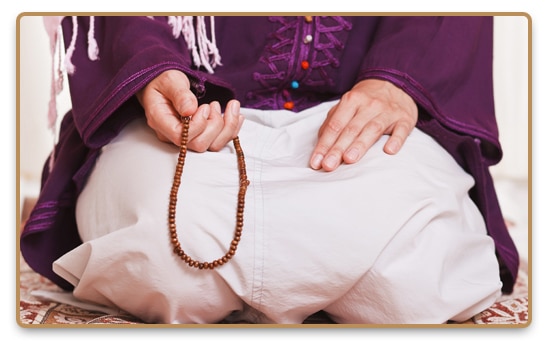
05 Feb Sufi Meditation
Definition
Sufi meditation (also known as Murāqabah) is a style of meditation practised in relation to Sufism, which is a form of Islamic mysticism. The ultimate goal is to use ritual to bring oneself closer to Allah and reach a level of spiritual purity.
Ultimately, this is done by focusing on the dissolution of the ego, mainly through deep concentration and focus upon God. Once the ego is gone, it is replaced by God. The end goal is to reach a state of “Baqaa billah”, which seems to be similar to nirvana in the Buddhist faith. In this state, one is divorced from the desire for rewards or power, and is said to be able to produce magnificent works of art or literature.
As expected, reaching this point involves years of focused Sufi meditation practice. Unlike many other forms of meditation, due to its overtly religious nature, it is impossible to practice Sufi meditation secularly.
The practices are confined to sitting meditations, but include walking and dancing as well.
Roots of Sufi Meditation
Many of the techniques used by Sufi orders are based upon the historical example set by the prophet Muhammad. Some orders even go to the extreme lengths of Sufi meditation retreats lasting up to 40 days. The linking of Sufism to the historical example set my Muhammad is so extreme, there were stories of Sufists refusing to eat fruits that weren’t specifically proven to have been consumed by him.
It is unclear exactly when Sufism began. There’s even suggestions that it may predate Islam, and just incorporated it into their belief system, but this is not conclusive. Sufism became formalized in the twelfth century when certain orders began to codify their systems.
Method
Cleansing Ritual in Preparation to Sufi Meditation
Much like in Muslim prayer, one much conduct a washing ritual before practising Sufi meditation. Be sure to give attention to the cleansing of hands, because they may have come in contact with the impure throughout the day. The feet should also be washed, in addition to the private parts if one has recently used the toilet.
The Best Time to Practice Sufi Meditation
It is suggested that the best time to practice Sufi meditation is late at night, preferably after midnight. Practitioners will find that since most people are asleep and there’s less external stimuli, that this is an easier time to have a beneficial meditation.
See How to Deepen Sufi Meditation Practice with a simple device.
This is not to say that it is pointless to try earlier than this, but the results can be a bit more effective. Even in the times when one is not actively meditating, they should go about their day in a state of mindfulness.
The Best Place to Practice Muraqabah
The best place to practice Muraqabah is somewhere quiet in your home where you are unlikely to be disturbed. It should also be somewhere without any outside light coming in. The only light should be a candle or oil lamp. Set out a prayer rug and face in the same direction as you would during prayer.

Multiple Methods of Sufi Meditation
There are multiple methods of Sufi meditation and whole books have been written about the subject. Here is only a quick overview of some of the methods used to help one become closer to the divine.
Dhikr: Focus Upon a Mantra
One of the most straight-forward methods is to focus upon a mantra, or Dhikr as it’s called in the Islamic faith. Often one kneels upon the prayer rug and repeats a phrase or prayer, though the position is less important than in other meditation methods. Some people like to use prayer beads to count the repetitions. The easiest Dhikr is to simply repeat Allah.
Many choose to synchronize this with the breath, inhaling with the first syllable and exhaling with the second. This practice is said to “inscribe the name of God on the heart”. Some even choose to write the name of God repeatedly to help focus on it. It is only natural for the mind to wander during meditation, so having a dhikr is an easy way to bring the focus back to God. When the mind begins to wander, one could repeat a verse from the Quran until a meditative state is obtained again. Instead of a mantra, some choose to practice something akin to mindfulness meditation, where the focus is on the sensation of breathing.

Heart Meditation
Another method is a heart meditation. The idea is to still the mind by bringing complete concentration on a love for God. It is best to begin this practice when one is already relaxed. Since God is an abstract concept to many, it can be hard to focus their love upon God at first. Many can begin with the feeling of love for a family member or loved one, then extend this to envelop God.
It is not uncommon for stray thoughts to emerge, so bring those thoughts into the feeling of love. With enough practice the mind will become empty. It is best to dedicate thirty minutes a day this meditation.
Whirling Dervish: The Dancing Meditation
Not all forms of Sufi meditation involve sitting in stillness. Like in Buddhism, there are also forms of moving meditations. Among the most common is a walking meditation. This is a form of mindful moving with the gaze focused at the feet. Some other groups meditate through a special kind of dance, often called the whirling dervish. The arms are raised, with the left hand pointing to the ground, while the right is pointing upwards towards the heavens. The practitioner spins to symbolize the orbit of the planets Often this is combined with the recitation of a dhikr.
Join a Sufi Order Before Start Practicing
It is highly recommended that if one wishes to begin a practice of Sufi meditation, they should join a Sufi order. This would put them in contact with masters who can lead them on a spiritual path. There are even meditation methods that stem from focusing on a deep love and devotion for a master, which can then be transferred onto a love for God.
Benefits
Given that this is a religious practice, it can be hard to have well-designed clinical studies of its benefits. The best we can do is look at reported spiritual benefits or generalize the effects of other similar styles of meditation. Overall, one should be a bit critical of much of the research on meditation, as not all studies are of high quality.
The Health Benefits of Sufi Meditation
If a breathing practice is used with Sufi meditation, this can possibly have some benefits including a reduction in stress and anxiety, which are some of the positive effects of meditation in general. There’s been studies that show that Sufi meditation specifically shows a similar effect. Some researchers are looking into the viability of using muraqabah as a supplemental therapy for anxiety and depression sufferers. It has been reported that these devotional practices can induce a hypnosis-like effect that may be very relaxing for some. Stress-releasing activities such as this may have a positive effect on our immune systems.

Start practicing today
The Egely Wheel is trusted by thousands of people who practice yoga, telekinesis, meditation and healing. This device is the best solution for measuring your energy flow and efficiency of healing, and you get instant feedback.
Meditation has also been shown to be able to decrease heart rate and lower one’s blood pressure and Sufi meditation has been shown to specifically have a similar effect. Both Mindfulness meditation and Sufi meditation have been shown to have some cognitive benefits as well, including an improvement in memory.
Health Benefits of the Whirling Dervish
There is some suggestion that the whirling meditation can be beneficial. It is said to create a feeling of ecstasy, which shouldn’t be a surprise when people are spinning around in circles. It may release endorphins. Still, the claims don’t seem to have much scientific backing.
The Placebo Effect
Even if the results of this practice are nothing more than a placebo, some theorize that the effects of placebos are strengthened by a strong belief system such as a religion. There are enough interesting developments that it may be worth exploring for people of the Islamic faith.
15 Sources +
Egely Wheel has strict sourcing guidelines and relies on peer-reviewed studies, academic research institutions, and medical associations. We avoid using tertiary references.
- Dhikr – https://en.wikipedia.org/
- Muraqabah – https://en.wikipedia.org/
- Sufism – https://en.wikipedia.org/
- The Sufi Meditation of the Heart – https://goldensufi.org/
- Sufi Meditation and Breathing Practices – https://liveanddare.com/
- With mindfulness, life’s in the moment – https://news.harvard.edu/
- Muraqaba as a Mindfulness-Based Therapy in Islamic Psychotherapy – https://pubmed.ncbi.nlm.nih.gov/
- Deconstructing the Placebo Effect and Finding the Meaning Response – https://www.researchgate.net/
- Effects of Mindfulness and Sufi Meditation on Anxiety and Mental Health of Females – https://www.researchgate.net/
- Meditation Practices for Health: State of the Research – https://www.researchgate.net/
- Sudarshan Kriya Yogic Breathing in the Treatment of Stress, Anxiety, and Depression: Part I—Neurophysiologic Model – https://www.researchgate.net/
- Mindfulness practice leads to increases in regional brain gray matter density – https://www.sciencedirect.com/
- The Meditative Techniques of Sufism – https://www.sonima.com/
- Sufi Meditation and Positive Mental Health – https://www.stressresilientmind.co.uk/
- Core Practices of Muraqaba / Sufi Meditation – https://www.sufimeditationcenter.com/
Discover more types of Meditation
Zhuanqi Meditation
Zhuanqi meditation is a Taoist breathing technique used to create a union between the mind and qi. The process is built upon a focus on the breath. Learn more...
Zazen Meditation
Zazen meditation is a type of Zen Buddhist meditation technique developed in Japan with the purpose of stilling the mind and removing desire. Learn more...
Vipassana Meditation
Vipassana meditation is a method used by Buddhists to help detach from the cycle of desire and accept the true nature of reality. Learn more...




